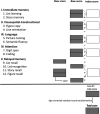The effect of risk factors on cognition in adult cochlear implant candidates with severe to profound hearing loss
- PMID: 36051206
- PMCID: PMC9426630
- DOI: 10.3389/fpsyg.2022.837366
The effect of risk factors on cognition in adult cochlear implant candidates with severe to profound hearing loss
Abstract
Hearing loss has been identified as a major modifiable risk factors for dementia. Adult candidates for cochlear implantation (CI) represent a population at risk of hearing loss-associated cognitive decline. This study investigated the effect of demographics, habits, and medical and psychological risk factors on cognition within such a cohort. Data from 34 consecutive adults with post-lingual deafness scheduled for CI were analyzed. Pure tone audiometry (PTA4) and Speech Discrimination Score (SDS) were recorded. The Repeatable Battery for Assessment of Neuropsychological Status for Hearing impaired individuals (RBANS-H) was used to measure cognition. Demographics (sex, age, years of education), habits (smoking, alcohol intake, physical inactivity), and medical factors (hypertension, diabetes, traumatic brain injury) were evaluated. Depression was measured using the Hospital Anxiety and Depression Scale (HADS), and social inhibition with the Type D questionnaire (DS14). All participants (mean age 62 ± 15 years) suffered from severe to profound hearing loss (PTA4:129 ± 60 dB; SDS:14 ± 24%). The mean RBANS-H total score was 83 ± 16. Participants reported a mean of years of formal education of 12 ± 5 years. The prevalence of habits and medical risk factors was: physical inactivity (29%), body mass index >30 (28%), traumatic brain injury (25%), hypertension (24%), heavy alcohol consumption (13%), smoking (13%), and diabetes (0%). Regarding psychological factors, the mean scores of social inhibition and depression were 10 ± 6 and 6 ± 5, respectively. The number of years of education was significantly correlated with the RBANS-H total score (p < 0.001), and with the domains "Immediate memory" (p = 0.003), "Visuospatial/constructional" (p < 0.001), and "Attention" (p < 0.001). The mean RBANS-H total score in participants who had university studies or higher level (12/34) was 97 ± 9, with the remaining participants reporting a mean score of 75 ± 15. Men performed better in the "Visuospatial/constructional" (p = 0.008). Physical inactivity was associated with lower scores in the "Delayed memory" (p = 0.031); hypertension correlated with lower RBANS-H total scores (p = 0.025) and "Attention" (p = 0.006). Depression and social inhibition were negatively correlated with RBANS-H total score and with the "Immediate memory," "Visuospatial/constructional," and "Attention" (all p < 0.05). In adults with late-onset deafness scheduled to CI, educational level has a significant effect. Additionally, sex, physical inactivity, hypertension, and psychological traits of social inhibition and depression may also influence cognitive status. Long-term studies with more participants would enable us better understand the effects different risk factors on cognitive status.
Keywords: RBANS-H; age; cognition; education; habits; risk factors; severe to profound hearing loss.
Copyright © 2022 Calvino, Sánchez-Cuadrado, Gavilán and Lassaletta.
Conflict of interest statement
The authors declare that the research was conducted in the absence of any commercial or financial relationships that could be construed as a potential conflict of interest.
Figures




Similar articles
-
Cognitive Changes Up to 4 Years After Cochlear Implantation in Older Adults: A Prospective Longitudinal Study Using the RBANS-H.Ear Hear. 2025 Mar-Apr 01;46(2):361-370. doi: 10.1097/AUD.0000000000001583. Epub 2024 Sep 4. Ear Hear. 2025. PMID: 39228026 Free PMC article.
-
Evaluation of Cognitive Functioning Before and After Cochlear Implantation in Adults Aged 55 Years and Older at Risk for Mild Cognitive Impairment.JAMA Otolaryngol Head Neck Surg. 2023 Apr 1;149(4):310-316. doi: 10.1001/jamaoto.2022.5046. JAMA Otolaryngol Head Neck Surg. 2023. PMID: 36795400 Free PMC article.
-
Effect of cochlear implantation on cognitive decline and quality of life in younger and older adults with severe-to-profound hearing loss.Eur Arch Otorhinolaryngol. 2022 Oct;279(10):4745-4759. doi: 10.1007/s00405-022-07253-6. Epub 2022 Jan 19. Eur Arch Otorhinolaryngol. 2022. PMID: 35044508 Free PMC article.
-
Identification of Pure-Tone Audiologic Thresholds for Pediatric Cochlear Implant Candidacy: A Systematic Review.JAMA Otolaryngol Head Neck Surg. 2018 Jul 1;144(7):630-638. doi: 10.1001/jamaoto.2018.0652. JAMA Otolaryngol Head Neck Surg. 2018. PMID: 29800000
-
Use of the RBANS to Evaluate Cognition in Patients with Schizophrenia and Metabolic Syndrome: a Meta-Analysis of Case-Control Studies.Psychiatr Q. 2022 Mar;93(1):137-149. doi: 10.1007/s11126-021-09889-9. Epub 2021 Mar 22. Psychiatr Q. 2022. PMID: 33751356 Review.
Cited by
-
Cognitive Changes Up to 4 Years After Cochlear Implantation in Older Adults: A Prospective Longitudinal Study Using the RBANS-H.Ear Hear. 2025 Mar-Apr 01;46(2):361-370. doi: 10.1097/AUD.0000000000001583. Epub 2024 Sep 4. Ear Hear. 2025. PMID: 39228026 Free PMC article.
-
Sustained Cognitive Improvement in Patients over 65 Two Years after Cochlear Implantation.Brain Sci. 2023 Dec 3;13(12):1673. doi: 10.3390/brainsci13121673. Brain Sci. 2023. PMID: 38137121 Free PMC article.
-
Cochlear implantation and cognitive function in the older adult population: current state of the art and future perspectives.Braz J Otorhinolaryngol. 2025 May-Jun;91(3):101544. doi: 10.1016/j.bjorl.2024.101544. Epub 2025 Jan 28. Braz J Otorhinolaryngol. 2025. PMID: 39879878 Free PMC article. Review.
References
-
- Alcaraz S., Hidalgo M., Godoy C., Fernández E. (2018). Spanish validation of the type D personality scale (DS14). Behav. Psychol. Psicol. Conduct 26, 195–209.
LinkOut - more resources
Full Text Sources
Miscellaneous

